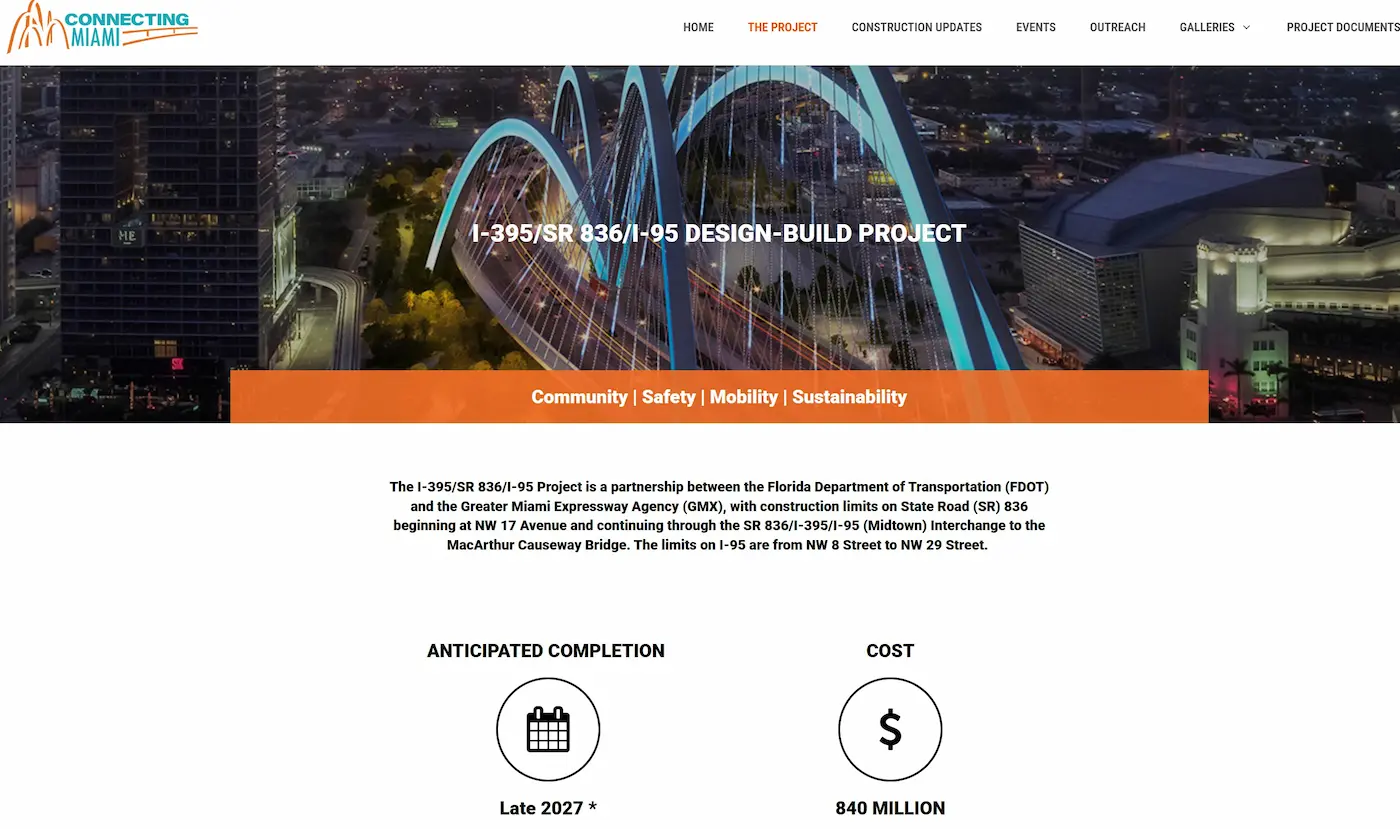Tabla de Contenido/ Table of Contents
- 1 Infrastructure in Miami-Dade: Aesthetic Luxury or Real Solutions? What is the true social value of these projects?
- 2 What is the true social value of these projects?
- 3 We ask:
- 4 How much does the “Signature Bridge” and its aesthetic elements cost?
- 5 Is this structure essential compared to affordable housing needs?
- 6 Priority vs. Unmet Basic Needs
- 7 Non-Competitive & Non-Transparent Spending
- 8 Where Are the 2025 Reports?
The reconstruction project of I-395/SR 836/I-95 in Miami, known as “Connecting Miami,” has sparked debate due to its high cost and the inclusion of aesthetic architectural elements, such as the “Signature Bridge” with its distinctive arches and lighting systems. The total cost of the project is estimated at approximately $840 million, funded by the Florida Department of Transportation (FDOT) and the Greater Miami Expressway Agency (GMX). I-395 Miami

Does a “Signature Bridge” with illuminated arms serve the people of Miami-Dade more than affordable housing?
Amid an unprecedented housing crisis in Miami-Dade, multimillion-dollar projects continue unabated. The county and the state keep approving and celebrating constructions that draw attention for their aesthetics but whose social utility is questionable.
A clear example is the “Underdeck” project, with an estimated budget of $82.6 million. Its goal: to create public spaces beneath the I-395 highway, connecting historically segregated neighborhoods. An idea that—while not a priority compared to the urgent need for shelter—at least seeks to integrate communities.
Yet, within the same reconstruction plan, another structure stands out: the so-called “Signature Bridge,” a work with “sculptural arms” and artistic lighting displays—whose exact cost remains undisclosed to the public.
We ask:
- How much of the $840 million budget for the I-395/I-95/I-836 project was allocated to this architectural piece that transports no one, houses no one, and alleviates no social crisis?
- Is it fair that while families face evictions, tens (or hundreds) of millions are spent on a decorative monumental walkway?
- Who makes these decisions? On what priorities?
Today, more than ever, Miami-Dade needs social bridges, not monumental sculptures funded by taxpayers.
Today, more than ever, we must ask:
What holds more value for the community?
A bridge with lights or 1,500 affordable homes to keep our elders, working families, and youth in their city?
This is not about opposing urban development. It’s about demanding that every government dollar—taxpayer money—translates into real solutions for real people’s problems.
Because while we keep building “icons,” the people who built this city are being pushed out of it.
How much does the “Signature Bridge” and its aesthetic elements cost?
The “Signature Bridge” is a centerpiece of the project, designed with six arches converging at a central point and equipped with an LED lighting system to highlight its design at night. However, publicly available documents do not break down the exact cost of these aesthetic features. WPLG
While exact figures are unavailable, it can be inferred that a significant portion of the total budget is allocated to these architectural and aesthetic components.
For example, the “Underdeck” project—part of the same reconstruction plan—has an estimated budget of $82.6 million and focuses on creating public spaces beneath the highway. Compared to the social utility of the “Signature Bridge,” the contrast is stark.
Is this structure essential compared to affordable housing needs?
Aesthetic elements in infrastructure projects can beautify the city and attract tourism. Yet, in today’s Miami-Dade—where over 60% of residents spend more than 30% of their income on rent—the priority of such spending is debatable.
If even a fraction of the budget for aesthetic features were redirected to affordable housing, it could significantly ease the burden on low-income residents. For instance:
- 82.6million (the∗Underdeck∗budget) could build (100,000 per unit).
Priority vs. Unmet Basic Needs
While structures like the “Signature Bridge” may add symbolic and aesthetic value, we must weigh their necessity against unmet basic needs—like housing. Transparent and balanced planning is crucial to ensure public resources directly benefit the community. FDOT Miami-Dade
Non-Competitive & Non-Transparent Spending
No-Bid Contracts: $420 Million Awarded Without Competition
In 2023, 1 in 5 contracts approved by the Miami-Dade Board of County Commissioners was awarded without public bidding. Though these 49 contracts represented just 9% of the county’s total subcontracting expenses (4.27 billion), involved $420 million in direct, non-competitive spending.
Mayor Daniella Levine Cava submitted a report justifying these awards, complying with Commissioner René García’s ordinance requiring quarterly transparency. However, the mayor has since requested reducing these reports to just once a year, claiming it’s “impossible” to predict no-bid contracts.
2024 projections included:
- $250M for Water & Sewer infrastructure.
- $80M for telecom services.
- $91.5M for recycling collection.
In total, 12% of active county contracts (215 of 1,786) were awarded without bidding, totaling $1.04 billion in non-competitive commitments. While proportionally smaller, this raises serious concerns about transparency, efficiency, and priorities in public spending.
Where Are the 2025 Reports?
As of now, no quarterly reports for 2025 on no-bid contracts have been published. This is alarming, given that the September 2023 ordinance requires the Mayor’s Office to submit these reports every quarter.
Yet, Mayor Levine Cava has proposed amending the ordinance to annual reporting, arguing it’s “impossible” to accurately forecast non-competitive contracts.
This lack of transparency fuels distrust in how public resources are managed.
🔎 SOURCES:
🚨 CALL TO ACTION:
Demand transparency and accountability from local leaders. Attend county meetings and ask:
- Why prioritize aesthetics over housing?
- Who benefits from no-bid contracts?
- Where are the 2025 reports?
Because Miami-Dade deserves solutions—not just sculptures.










